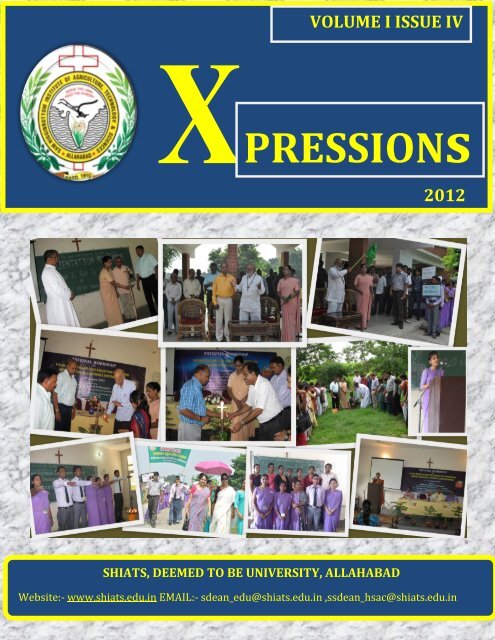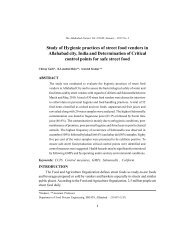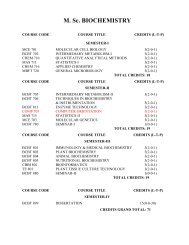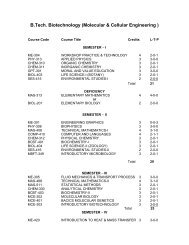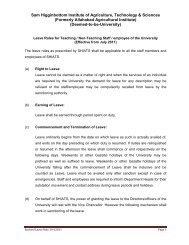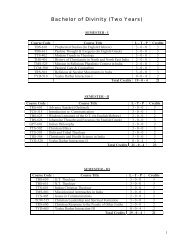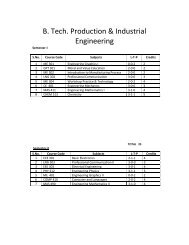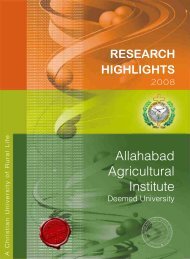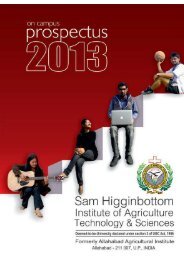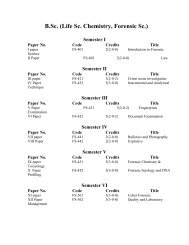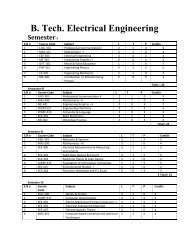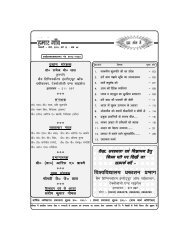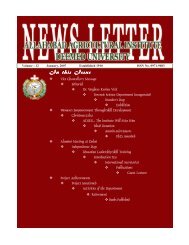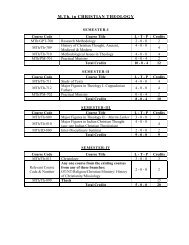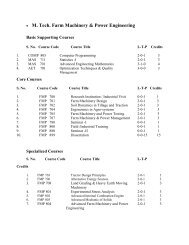PRESSIONs S - Shiats.edu.in
PRESSIONs S - Shiats.edu.in
PRESSIONs S - Shiats.edu.in
Create successful ePaper yourself
Turn your PDF publications into a flip-book with our unique Google optimized e-Paper software.
X<br />
2012<br />
+++++++++++++++++++++++++++++++++++++++++++++++++++++++<br />
VOLUME I ISSUE IV<br />
<strong>PRESSIONs</strong><br />
S<br />
Dec 2012<br />
.<br />
SHIATS, DEEMED TO BE UNIVERSITY, ALLAHABAD<br />
Website:- www.shiats.<strong>edu</strong>.<strong>in</strong> EMAIL:- sdean_<strong>edu</strong>@shiats.<strong>edu</strong>.<strong>in</strong> ,ssdean_hsac@shiats.<strong>edu</strong>.<strong>in</strong>
EDITORIAL<br />
CONTENTS<br />
1. Message of Pro VC (Academics)<br />
2. Message of HOD<br />
3. Quality and Excellence <strong>in</strong> Higher<br />
Education<br />
4. Trust & be Blessed<br />
5. Our Achievers<br />
6. Workshops<br />
7. Communication <strong>in</strong> Teach<strong>in</strong>g<br />
-Learn<strong>in</strong>g Process<br />
8. ICT <strong>in</strong> Indian Educational<br />
Sector<br />
9. A Milestone <strong>in</strong> My Life<br />
10. A Special Day<br />
11. An Experience to Remember<br />
12. Student Council 2012-13<br />
13. Competitions<br />
14. Alumni Corner<br />
15. Photo Gallery<br />
L to R<br />
Mrs. K.S<strong>in</strong>ghal, Dr.S.Masih, Mrs.K.Cutt<strong>in</strong>g<br />
Greet<strong>in</strong>gs to all <strong>in</strong> the name of our Lord<br />
and Savior Jesus Christ.<br />
This is the first issue of this session. A<br />
new year, a new issue, are like a whiff of<br />
fresh air, a new beg<strong>in</strong>n<strong>in</strong>g, where you<br />
nurture the green shoots (pupil teachers)<br />
and help them blossom <strong>in</strong>to<br />
wholesome professionals, who warm<br />
up to the students under their care,<br />
mak<strong>in</strong>g the world a better place to live <strong>in</strong>.<br />
The session began with the customary<br />
orientation programme, with the faculty<br />
members pool<strong>in</strong>g <strong>in</strong> with PPT<br />
presentations, <strong>in</strong>troduc<strong>in</strong>g the students to<br />
the Teacher Education Dept., thus giv<strong>in</strong>g<br />
them a peep <strong>in</strong>to the events gone by and<br />
the strides taken to make this dept.<br />
worthy of note.<br />
The events with<strong>in</strong> these few months<br />
<strong>in</strong>clude two national workshops, literacy<br />
rally, practice teach<strong>in</strong>g, teachers’ day, solo<br />
s<strong>in</strong>g<strong>in</strong>g and extempore competitions, etc.<br />
We are highly <strong>in</strong>debted to our dean Pro<br />
V.C.(Academics)Prof.(Dr.)Newman<br />
Fernandes, for his constant motivation<br />
and encouragement, our HOD<br />
Prof.(Dr.)Sister Marion Mathew, for her<br />
constant and able guidance, our<br />
colleagues for their valued <strong>in</strong>puts and the<br />
students for the growth of the content,<br />
that all helped us <strong>in</strong> br<strong>in</strong>g<strong>in</strong>g out this<br />
thermometer of our development and<br />
vibrancy. A special mention needs to be<br />
made of our alumni, Amrish George<br />
Frederick who helped design and<br />
construct this newsletter and B.Ed<br />
students Imran and Zebish for their<br />
consistent and s<strong>in</strong>cere assistance.
MESSAGE<br />
Pro.Dr.Newman Fernandes<br />
Pro V.C.(Academics)<br />
Dean,Humanities,Social<br />
Sciences & Education<br />
It is a matter of immense pleasure and pride that the<br />
department of Teacher Education is ready with the fourth<br />
issue of their Digital Newsletter. All the activities and<br />
workshops organised, show that the entire department is<br />
work<strong>in</strong>g hard and diligently, to tra<strong>in</strong> and equip the students<br />
under their care, <strong>in</strong>to holistic personalities, who are adept<br />
both <strong>in</strong> academics and co-curricular activities.<br />
I wish them all a Very Happy New Year.<br />
‘The mediocre teacher tells,<br />
The good teacher expla<strong>in</strong>s,<br />
The superior teacher demonstrates,<br />
The great teacher <strong>in</strong>spires’.<br />
-William Arthur Ward
MESSAGE<br />
Prof. (Dr.) Sr .Marion Mathew C.J.<br />
Head, Department of Teacher Education<br />
“Teachers have three loves; love of learn<strong>in</strong>g, love of learners, and the love of br<strong>in</strong>g<strong>in</strong>g the first two loves<br />
together.” Scott Hayden<br />
It is a matter of great joy and pride that the Dept. of Teacher Education, SHIATS, Allahabad, is<br />
br<strong>in</strong>g<strong>in</strong>g out the first issue of their Digital news letter of the Academic Session 2012-2013.<br />
Education is the ma<strong>in</strong> means for social transformation. Only knowledge, science and wisdom<br />
can take the vast majority of our Indians from the poverty and misery <strong>in</strong> which they live. We<br />
<strong>edu</strong>cate our students for a new century characterized by rapid and constant changes. A changed<br />
world is demand<strong>in</strong>g a new and <strong>in</strong>novative way of teach<strong>in</strong>g - learn<strong>in</strong>g process. The role of a<br />
teacher <strong>in</strong> society is vital and irreplaceable. No other profession can have an <strong>in</strong>fluence more<br />
profound than that of teach<strong>in</strong>g.<br />
We, at Allahabad School of Education, try to ma<strong>in</strong>ta<strong>in</strong> a balance between theory and practice <strong>in</strong><br />
teacher <strong>edu</strong>cation by provid<strong>in</strong>g opportunities to the teacher tra<strong>in</strong>ees to critically analyze the vital<br />
issues that challenge the <strong>edu</strong>cation system. We try to equip our tra<strong>in</strong>ees with skill sets required<br />
to be an effective teacher <strong>in</strong> today’s ever chang<strong>in</strong>g world. We make conscious effort to tra<strong>in</strong><br />
them to cultivate and nurture noble values such as tolerance, compassion, k<strong>in</strong>dness, empathy<br />
and love for children. The faculty on their part focuses their attention also to sensitize the<br />
student teachers towards egalitarianism, equality of sexes, protection of environment and<br />
promot<strong>in</strong>g peace and harmony <strong>in</strong> the society.<br />
The digital newsletter mirrors and aptly captures how the School of Education has been able to<br />
live up to its vision and objectives. The curricular and co-curricular activities provide them a<br />
blend of teacher professionalism and opportunity to showcase their talents and f<strong>in</strong>e-tune their<br />
skills.
PROMOTING A CULTURE OF QUALITY AND EXCELLENCE IN HIGHER EDUCATION<br />
INSTITUTIONS: ISSUES AND CHALLENGES<br />
Prof (Dr.) Sr.Marion Mathew C. J, Head, Department of Teacher Education,<br />
was privileged to be nom<strong>in</strong>ated by the Hon’ble Vice Chancellor to attend the<br />
Association of Indian Universities’ Conference at Bilaspur on 26 th & 27 th of<br />
October, 2012 She presented a paper on ‘ Promot<strong>in</strong>g a Culture of Quality<br />
and Excellence <strong>in</strong> Higher Education Institutions: Issues and Challenges.’ The<br />
paper addressed the culture of quality and excellence and its parameters,<br />
<strong>in</strong>clud<strong>in</strong>g accountability, improvement requirements, and quality systems<br />
from conceptual, historical and policy perspectives and the challenges<br />
<strong>in</strong>volved <strong>in</strong> the pursuit of excellence <strong>in</strong> Higher <strong>edu</strong>cation. It also analysed the<br />
status of India’s higher <strong>edu</strong>cation system. Some important po<strong>in</strong>ts discussed<br />
are presented herewith.<br />
Quality <strong>edu</strong>cation can only br<strong>in</strong>g about positive values <strong>in</strong> an <strong>in</strong>dividual<br />
to make him a good human be<strong>in</strong>g. Education <strong>in</strong> India is plagued with <strong>in</strong>herent problems and<br />
<strong>edu</strong>cational contexts are constantly <strong>in</strong> a state of flux. .The Endeavour for quality <strong>in</strong> any field<br />
of work is a never-end<strong>in</strong>g quest. For India today, quality <strong>in</strong> higher <strong>edu</strong>cation is the key priority<br />
and this must be achieved keep<strong>in</strong>g <strong>in</strong> m<strong>in</strong>d the issues of relevance, costs equity and<br />
<strong>in</strong>ternational standards.<br />
Crux :<br />
CULTURE OF QUALITY<br />
AND EXCELLENCE<br />
PARAMETERS<br />
ACCOUNTABILTY<br />
INNOVATIVE<br />
APPROACH<br />
QUALITY<br />
SYSTEMS<br />
NEW<br />
TRENDS
Parameters for Quality:<br />
Facilities for faculty exchange<br />
& student exchange programs<br />
Effective <strong>in</strong>stitutional<br />
management & alumni relations.<br />
Offer<strong>in</strong>g relevant courses for a<br />
knowledge society<br />
Provid<strong>in</strong>g value based<br />
<strong>edu</strong>cation to develop leadership.<br />
Involv<strong>in</strong>g latest technology <strong>in</strong><br />
dissem<strong>in</strong>at<strong>in</strong>g <strong>edu</strong>cation.<br />
Headship on rotation to ensure<br />
<strong>in</strong>novation and growth.<br />
Faculty promotions based on<br />
performance.<br />
Shar<strong>in</strong>g of resources and<br />
expertise<br />
‘Model of Education’ needs to be<br />
Re-visioned and Re-created
So Development of Quality Culture Requires:<br />
An open and active commitment to quality at all levels, a will<strong>in</strong>gness to engage <strong>in</strong> self<br />
evaluation, a firm regulatory frame work, clarity and consistency of proc<strong>edu</strong>res, explicit<br />
responsibility for quality control and quality assurance, appropriate device to obta<strong>in</strong> feedback<br />
from stakeholders, a clear commitment to identify<strong>in</strong>g and dissem<strong>in</strong>at<strong>in</strong>g good practice, prompt,<br />
appropriate and managerial action to redress problems, supported by adequate <strong>in</strong>formation.<br />
Teach<strong>in</strong>g is central to our mission, but we must admit that active <strong>in</strong>volvement <strong>in</strong> scholarly<br />
research and professional practice by faculty will translate <strong>in</strong>to better teach<strong>in</strong>g. As per the<br />
f<strong>in</strong>d<strong>in</strong>gs of the study on India’s research output conducted by Thomson Reuters and<br />
collaboration reported <strong>in</strong> ‘Times of India’ newspaper on 2 nd Oct.2012 reveals that only 3.5%<br />
global research output comes from India. “Indian higher <strong>edu</strong>cation is faced with powerful<br />
dilemmas and difficult choices-public/private, access/equity, uncerta<strong>in</strong> regulation, different<br />
teach<strong>in</strong>g standards and contested research quality.” The report said research <strong>in</strong> various<br />
discipl<strong>in</strong>es will certa<strong>in</strong>ly enhance quality <strong>in</strong> <strong>edu</strong>cation.<br />
Conclusion:<br />
So it is reaffirmed that parameters of a strong quality culture ensure learn<strong>in</strong>g and teach<strong>in</strong>g<br />
<strong>in</strong>novation. Quality processes both <strong>in</strong>ternal and external lock <strong>in</strong> together. Therefore, quality<br />
culture is about adopt<strong>in</strong>g a self-critical reflexive approach as an <strong>in</strong>stitution: a community of<br />
students and staff. Quality processes, <strong>in</strong>ternally and externally, if they are improvement-oriented<br />
will provide a framework for the effective operation of communicative learn<strong>in</strong>g environment.
Trust God And Be Blessed<br />
Dr. Nathaniel Stephen<br />
Associate Professor &<br />
Dy.Registrar (Edu)<br />
Greet<strong>in</strong>gs to all of you <strong>in</strong> the name of our Lord & Saviour Jesus Christ.<br />
Today the world’s long<strong>in</strong>g for long and prosperous life, success, favour, good health and<br />
material prosperity. The Proverb 23:1-10 speaks about five keys or secrets of these benefits,<br />
how we can receive these benefits <strong>in</strong> our own life. They are as follow<strong>in</strong>g:-<br />
Long and prosperous life:<br />
Keep the teach<strong>in</strong>g and commandment of God <strong>in</strong> your heart and don’t allow worldly th<strong>in</strong>gs to<br />
enter <strong>in</strong> your heart as it is the dwell<strong>in</strong>g place of God, then they will help you to live a long and<br />
prosperous life.<br />
Favour from God and Man both:<br />
Keep Love and loyalty as necklace <strong>in</strong> your neck and put them <strong>in</strong> your heart, then you will be<br />
honoured and favoured by God and Man both.<br />
Key for True success:<br />
Do not lean on your own understand<strong>in</strong>g but always trust the Lord, then he will clear the road for<br />
you and grant you wisdom for True success.<br />
Key for Good & sound health:<br />
Never th<strong>in</strong>k that you are wise enough but respect the Lord and stay away from Evil, then this<br />
will make you healthy and strong.<br />
Material prosperity:<br />
Honor your Lord by giv<strong>in</strong>g him first place <strong>in</strong> everyth<strong>in</strong>g of your life followed by giv<strong>in</strong>g your<br />
time, talent, money & first portion of every bless<strong>in</strong>g, then he will bless our time, talent, money<br />
and there shall be overflow of bless<strong>in</strong>gs.<br />
May God bless us to remember these teach<strong>in</strong>gs and make us channel of bless<strong>in</strong>gs for our<br />
family, for our Institution.<br />
Wish<strong>in</strong>g you a happy & prosperous new year.
VIII CONVOCATION 2012<br />
OUR ACHIEVERS<br />
Dr.Syed Hasan Qasim Dr.Bhawna Moses Dr.V<strong>in</strong>i Saxsena<br />
Amrish George Frederick<br />
M.Ed Gold Medal<br />
Suhaila Aftab<br />
B.Ed.Gold Medal
VALUE BASED HIGHER EDUCATION FOR<br />
PROMOTING GENDER EQUALITY AND WOMEN<br />
EMPOWERMENT<br />
A two day National Workshop on ‘Value Based Higher Education for Promot<strong>in</strong>g Gender<br />
Equality & Women’s Empowerment’ was organised on 6 th and 7 th August 2012. It was attended<br />
by over 200 participants. In her welcome address, Prof. (Dr.) Sr. Marion Mathew C.J., Head,<br />
Dept. of Teacher Education welcomed all. She said Prof. Pandey was an em<strong>in</strong>ent <strong>edu</strong>cationist of<br />
high repute, hav<strong>in</strong>g authored many books and publications. He was a dynamic academician. She<br />
said our priorities need to be revised and our social value system reviewed to empower women.<br />
In his <strong>in</strong>augural address, Prof. (Dr.) Newman Fernandez, Dean, Faculty of Humanities, Social<br />
Sciences and Education, through a lively questions and answer session said that values, gender<br />
equality and women empowerment were necessary for a better life. The suggestion of the<br />
workshop, should become a part of our lives. In his keynote address the guest speaker, Prof.<br />
R.S. Pandey, Former Dean, Faculty of Arts and Head, Dept. of Education, University of<br />
Allahabad, said that this theme has been debated from ancient times. Total equality of genders<br />
is an ideal situation, but a balance can be made possible’.<br />
In the post lunch session, Prof. Nityanand Pandey <strong>in</strong> his address,said that a value crisis existed<br />
<strong>in</strong> the contemporary Indian and Global Society. Its notable dimension were the Individual<br />
Dimension of ris<strong>in</strong>g consumerism and selfishness, social dimension of exploitation and cultural<br />
dimension of chang<strong>in</strong>g lifestyles and banishment of ethics. We need to develop a modern Indian<br />
value tradition, to tide over the present scenario.Day one of the workshop, gave food for<br />
thought for all and some concrete suggestions and hope for a better society.<br />
On the second day Prof. (Dr.) Sr. Marion Mathew C.J. welcomed the Guest Speaker Prof. (Dr.)<br />
Sumita Parmar, Professor, Dept. of English, University of Allahabad and Director, Centre of<br />
Women Studies for the first session. The guest speaker spoke on how the Indian women<br />
struggled through decades to achieve gender equality and even today 50% fail to enroll<br />
themselves <strong>in</strong> schools and of the rema<strong>in</strong><strong>in</strong>g fifty percent, twelve percent are dropouts. So today<br />
it is the need of the hour to empower the female child for a better future tomorrow.<br />
The second session was conducted by the Head of the Department. She spoke about the<br />
upliftment of women and its significance. She also discussed about the parameters of<br />
empowerment process and concluded that empower<strong>in</strong>g women is only through <strong>edu</strong>cation so we<br />
have to build up a right system of <strong>edu</strong>cation that upholds pr<strong>in</strong>ciples such as equality, ethics and<br />
empowerment of women.
PROMOTING HEALTH AND FITNESS THROUGH<br />
MEDITATION AND NUTRITION<br />
The two day National Workshop on ‘Promot<strong>in</strong>g Health and Fitness through Meditation &<br />
Nutrition’ was <strong>in</strong>augurated on 6 th September, 2012. The HOD, Prof. (Dr.) Marion Mathew<br />
welcomed. She outl<strong>in</strong>ed the objectives of the workshop say<strong>in</strong>g that it was very relevant as our<br />
youth needed to know that they could not neglect their bodies and m<strong>in</strong>ds any more. The whole<br />
world was celebrat<strong>in</strong>g the ‘World Nutrition Week’ from 1 st Sept to 7 th Sept. 2012, to deliberate<br />
on this very vital and topical issue. The chief guest was Padmashree Dr. Paul Teliath, the world<br />
renowned cancer specialist and presently the Director of the Regional Cancer Institute, Kamla<br />
Nehru Memorial Hospital, Allahabad. He stressed the fact that it was our lifestyle that gave rise<br />
to various diseases like cancer. He compared the types of cancers usually encountered <strong>in</strong> the<br />
different parts of India and <strong>in</strong> the west. So our way liv<strong>in</strong>g was very important. The guest<br />
speaker Dr. Rahul Verma, Associate Professor, Dept. of Physical Education, APS University,<br />
Rewa, M.P. traced the history of physical <strong>edu</strong>cation right from the Vedas Buddha and Sparta <strong>in</strong><br />
Greece. He said that health, fitness, meditation & nutrition were all <strong>in</strong>terrelated. Today youth<br />
must take of their physical, mental, emotional and spiritual health and environment, to become<br />
better human be<strong>in</strong>gs. The second speaker Dr. Virg<strong>in</strong>ia Paul, Associate Professor, Ethel<strong>in</strong>d<br />
School of Home Science, SHIATS spoke on what constituted a proper diet, through her power<br />
po<strong>in</strong>t presentation on ‘Fitness through Nutrition’. She dwelt at length on the types of fruit that<br />
supply us with prote<strong>in</strong>, carbohydrates, m<strong>in</strong>eralss etc. and what was the proper balanced diet for<br />
every age group.Prof. Dr. Newman Fernandes,Pro V.C.(Academics), Dean, Faculty of<br />
Humanities, Social Sciences & Education, <strong>in</strong> his address to the gather<strong>in</strong>g, said it was high itme<br />
that we all seriously took charge of our bodies by proper exercise, timely <strong>in</strong>take of food and<br />
relaxed mental framework.<br />
The workshop concluded on 7 th September, 2012. The guest speaker for the day was Shri<br />
Gyanmata Dr. Radha Satyam, founder of Kriyayoga Research Institute, Jhunsi, Allahabad, a<br />
professionally qualified doctor who has worked for two years as a gynecologist <strong>in</strong> the Kamla<br />
Nehru Memorial Hospital, Allahabad. She said that the solutions of all our problems and<br />
diseases lie with<strong>in</strong> us. We must know ourselves, that we are a part of the div<strong>in</strong>e be<strong>in</strong>g. We must<br />
meditate with a relaxed m<strong>in</strong>d every day. The second technical session was taken by HOD, Prof.<br />
(Dr.) Sr. Marion Mathew C.J. who showed a unique power po<strong>in</strong>t presentation on the ten hand<br />
mudras. A selected group of students , presented a demonstration while the slides were be<strong>in</strong>g<br />
expla<strong>in</strong>ed by her. She said that health is quite literally, <strong>in</strong> our hands .She said that all can benefit<br />
immensely by practic<strong>in</strong>g meditation and the ten mudras beg<strong>in</strong>n<strong>in</strong>g with Gyan Mudra and the<br />
last be<strong>in</strong>g the Mudra of the Heart. The programme was attended by a gather<strong>in</strong>g consist<strong>in</strong>g of<br />
faculty members and students of SHIATS and other Institutes from Allahabad and outside.<br />
Everyone realized that our health. Physical, Mental and spiritual must be taken care of<br />
seriously. The program came to end on a very positive note.
PROCEEDINGS OF THE WORKSHOPS AT A GLANCE
ROLE OF COMMUNICATION IN EFFECTIVE<br />
TEACHING-LEARNING PROCESS<br />
Dr Ajay Kumar S<strong>in</strong>gh<br />
Assistant Professor<br />
Education is both a personal and public learn<strong>in</strong>g experience. The<br />
challenge of <strong>edu</strong>cators is to l<strong>in</strong>k the properties of learn<strong>in</strong>g with the ability<br />
to create communities of learn<strong>in</strong>g and <strong>in</strong>quiry that <strong>in</strong>tegrates the<br />
cognitive, social and teach<strong>in</strong>g presence to meet <strong>in</strong>dividual and societal<br />
needs. Learn<strong>in</strong>g has the particular properties to <strong>in</strong>tegrate the <strong>in</strong>teractive<br />
and reflective characteristics to enhance cognitive presence beyond that<br />
<strong>in</strong> even small face-to-face groups. Calls for high quality professional<br />
development are perennial; there rema<strong>in</strong>s a shortage of such programs.<br />
Effective teach<strong>in</strong>g-learn<strong>in</strong>g process has two important variables viz<br />
content proficiency and teach<strong>in</strong>g skills are:-<br />
1. Understand<strong>in</strong>g emotion and vulnerability: The world ahead will become more and<br />
more people-centered with an emphasis on human rights and dignity. Messages based<br />
on s<strong>in</strong>cerity and genu<strong>in</strong>eness of feel<strong>in</strong>g, us<strong>in</strong>g mean<strong>in</strong>gful thoughts and vivid<br />
examples, will create the most powerful impact <strong>in</strong> communication. Intimacy, well<br />
thought out and used with care, allows a side-by-side, peer dialogue.<br />
2. Communication by example: Walk<strong>in</strong>g the talk is motivation <strong>in</strong> its purest form.<br />
21st Century communication will become easier <strong>in</strong> some respects—just look at e-mail,<br />
fax and the <strong>in</strong>formation highway—and harder <strong>in</strong> the sense that the constant change<br />
characteriz<strong>in</strong>g the new era will force us to th<strong>in</strong>k and communicate at an accelerated level.<br />
Even positive change can be disruptive and can break down communication l<strong>in</strong>es.<br />
3. Any <strong>in</strong>put needs a response: With all the "quickie communication" available to us,<br />
which will only <strong>in</strong>crease <strong>in</strong> the century ahead, an emphasis on response is critical.<br />
Follow-up to a phone call, request, suggestion or completion of assigned work assures<br />
that someone is listen<strong>in</strong>g. F<strong>in</strong>d other's "buttons" and encourage them to dialogue.<br />
4. Help others see the total picture: Communication today and <strong>in</strong>to the next century<br />
will need to address the cont<strong>in</strong>u<strong>in</strong>g demand of workers to know what the total<br />
organizational picture is, what is happen<strong>in</strong>g to others <strong>in</strong> the organization and how they<br />
are impacted.<br />
5. Acquire and develop knowledge: It is difficult to be true without acknowledg<strong>in</strong>g that<br />
the base of all communication is knowledge. As we move to the next century, knowledge<br />
will be accelerated. The steps we take now to explore our world— understand<strong>in</strong>g how<br />
others th<strong>in</strong>k and feel, know<strong>in</strong>g what is happen<strong>in</strong>g around us <strong>in</strong> all areas of knowledge—<br />
will determ<strong>in</strong>e the clarity and quality with which we communicate.
Learn<strong>in</strong>g Effectiveness<br />
Learn<strong>in</strong>g effectiveness must <strong>in</strong>clude consideration of social, cognitive and teach<strong>in</strong>g presence.<br />
While the focus <strong>in</strong> this section is on cognitive presence and implications for learn<strong>in</strong>g<br />
effectiveness, it should be realized that it is theoretically and practically impossible to separate<br />
this discussion from teach<strong>in</strong>g and social presence.<br />
To understand learn<strong>in</strong>g effectiveness for learn<strong>in</strong>g is to first appreciate what is unique about this<br />
medium. To reiterate, it is not the reflective and connectivity (i.e., collaborative) properties of<br />
learn<strong>in</strong>g taken separately. It is how we <strong>in</strong>tegrate and use the capabilities of learn<strong>in</strong>g <strong>in</strong> a<br />
synergetic manner that makes it unique.<br />
Effective Practices<br />
The discussion here is shaped by an appreciation for the properties of learn<strong>in</strong>g as well as<br />
creat<strong>in</strong>g and facilitat<strong>in</strong>g cognitive presence for higher-order learn<strong>in</strong>g outcomes. Cognitive<br />
presence for purposes of higher-order learn<strong>in</strong>g is associated with effectively facilitat<strong>in</strong>g and<br />
develop<strong>in</strong>g reflective th<strong>in</strong>k<strong>in</strong>g, self-directed learn<strong>in</strong>g and meta-cognitive awareness. In other<br />
words, recogniz<strong>in</strong>g and utiliz<strong>in</strong>g the unique capability of asynchronous learn<strong>in</strong>g networks to<br />
provide reflective and collaborative learn<strong>in</strong>g opportunities is the first step <strong>in</strong> enhanc<strong>in</strong>g learn<strong>in</strong>g<br />
effectiveness..<br />
Reflection<br />
The first po<strong>in</strong>t to be made is that effective learn<strong>in</strong>g must utilize the strengths of written<br />
communication. To use written communication effectively, learners must be given the<br />
opportunity to revise and ref<strong>in</strong>e their comments and ideas. The permanent nature of written<br />
communication <strong>in</strong> an onl<strong>in</strong>e context provides for a systematic approach to construct<strong>in</strong>g<br />
mean<strong>in</strong>g, particularly <strong>in</strong> difficult and ill-def<strong>in</strong>ed content areas. However, the use of<br />
asynchronous learn<strong>in</strong>g requires plann<strong>in</strong>g, structure, and the facilitation of the discourse toward a<br />
clear goal.<br />
From a content perspective, the key is not to <strong>in</strong>undate students with <strong>in</strong>formation. The first<br />
responsibility of the teacher or content expert is to identify the central idea and have students<br />
reflect upon and share their conception. Assessment must also be designed to measure depth of<br />
understand<strong>in</strong>g if that is the <strong>in</strong>tended learn<strong>in</strong>g outcome. Model<strong>in</strong>g reflective <strong>in</strong>quiry and<br />
<strong>in</strong>creas<strong>in</strong>g meta cognitive awareness can be greatly assisted by explicitly shar<strong>in</strong>g a model of the<br />
th<strong>in</strong>k<strong>in</strong>g and learn<strong>in</strong>g process such as practical <strong>in</strong>quiry<br />
Collaboration<br />
Reflective activities can only be artificially separated from the collaborative process of learn<strong>in</strong>g.<br />
Collaborative asynchronous learn<strong>in</strong>g can also be susta<strong>in</strong>ed <strong>in</strong> a unique manner. At the heart is<br />
that this collaboration is susta<strong>in</strong>ed over a longer period of time. This dialogic writ<strong>in</strong>g process is<br />
not so spontaneous and fleet<strong>in</strong>g as verbal communication. These characteristics, however,<br />
provide new possibilities as well as challenges.
ROLE OF ICT IN INDIAN EDUCATIONAL SECTOR<br />
It is desirable that affordable ICT tools and techniques should be<br />
<strong>in</strong>tegrated <strong>in</strong>to classroom <strong>in</strong>structions right form primary stage so as to<br />
enable students develop their requisite skills. The <strong>edu</strong>cation ICT policy<br />
should identify specific ways <strong>in</strong> which the application of ICT will<br />
enhance the <strong>edu</strong>cational capacity and the capability of higher <strong>edu</strong>cation<br />
<strong>in</strong>stitutions <strong>in</strong>formation will go a long way <strong>in</strong> dissem<strong>in</strong>at<strong>in</strong>g <strong>edu</strong>cation.<br />
Dr. Syed Hasan Qasim<br />
Assistant Professor<br />
Information technology aims to improve students’ performance by the <strong>in</strong>telligent<br />
application of technology and hopes this will <strong>in</strong>crease the effectiveness and efficiency of<br />
teach<strong>in</strong>g and learn<strong>in</strong>g process. There is now an irreversible trend among countries <strong>in</strong> Asia and<br />
the Pacific to transform their teach<strong>in</strong>g force and <strong>edu</strong>cational staff <strong>in</strong>to technology literate and<br />
skilled workers. In almost all countries <strong>in</strong> the region, <strong>in</strong>clud<strong>in</strong>g emerg<strong>in</strong>g countries, teachers <strong>in</strong><br />
primary, secondary and tertiary levels are be<strong>in</strong>g tra<strong>in</strong>ed <strong>in</strong> the use of <strong>in</strong>formation and<br />
communication technologies (ICTs) <strong>in</strong> <strong>edu</strong>cation with vary<strong>in</strong>g degree and scope (UNESCO,<br />
2003). It was observed that an <strong>in</strong>creas<strong>in</strong>g number of countries are now undertak<strong>in</strong>g tra<strong>in</strong><strong>in</strong>g to<br />
develop skills <strong>in</strong> the use of ICT <strong>in</strong> teach<strong>in</strong>g and other school activities, <strong>in</strong>clud<strong>in</strong>g classroom<br />
management, to ensure the teachers br<strong>in</strong>g their skills to actual classroom teach<strong>in</strong>g. Importance<br />
of <strong>edu</strong>cation <strong>in</strong> almost all walks of life has <strong>in</strong>creased with the support of <strong>in</strong>formation and<br />
communication technologies (ICT). Dur<strong>in</strong>g the past 20 years, the use of ICT has fundamentally<br />
changed the work<strong>in</strong>g of <strong>edu</strong>cation. In the current environment-conscious world, the importance<br />
of <strong>edu</strong>cation and acceptability of ICT as a social necessity has been <strong>in</strong>creas<strong>in</strong>g. Social<br />
acceptability of <strong>in</strong>formation and communication tools is necessary to improve the mobility <strong>in</strong><br />
the society and <strong>in</strong>crease the pitch for equity and social justice. Education as a qualitative<br />
development is not conf<strong>in</strong>ed with<strong>in</strong> the classroom structure. The modern tools of ICT such as<br />
eLearn<strong>in</strong>g and onl<strong>in</strong>e practice of learn<strong>in</strong>g and gett<strong>in</strong>g <strong>in</strong>formation are much sought after by the<br />
students as well as by the <strong>in</strong>stitutions.<br />
The government is spend<strong>in</strong>g a lot of money on ICT. In the higher <strong>edu</strong>cation<br />
sector, the National Mission on Education is emphasis<strong>in</strong>g on the role of ICT <strong>in</strong> <strong>in</strong>creas<strong>in</strong>g the<br />
enrolment ratio <strong>in</strong> higher <strong>edu</strong>cation. School <strong>edu</strong>cation <strong>in</strong> India has a problem of high dropout<br />
rate and we need to work on how to decrease this rate. Similarly, <strong>in</strong> the field of higher<br />
<strong>edu</strong>cation, we need to <strong>in</strong>crease the number of students. Therefore, if we make our learn<strong>in</strong>g more<br />
engag<strong>in</strong>g with the use of ICT, it can completely change how our <strong>edu</strong>cation system works. Also,<br />
we should exam<strong>in</strong>e the challenges of cost-factor and availability of tra<strong>in</strong>ed teachers <strong>in</strong> the<br />
process of dissem<strong>in</strong>ation of <strong>edu</strong>cation with the help of ICT. <strong>in</strong> the use of ICT resources across<br />
prove that students exhibit substantial improvement <strong>in</strong> learn<strong>in</strong>g. India is develop<strong>in</strong>g as a<br />
knowledge economy and it cannot function without the support of ICT. The gap between<br />
demand and supply of higher <strong>edu</strong>cation has necessitated the governments and <strong>in</strong>stitutions to<br />
formulate the policies for the better use of ICT. And, <strong>in</strong> order to bridge the gap, it is necessary<br />
to evolve the cooperation between the public and private sectors.
A Milestone <strong>in</strong> My Life<br />
Shar<strong>in</strong>g my experience of qualify<strong>in</strong>g the June 2012 UGC NET<br />
exam<strong>in</strong>ation gives me immense pleasure. I thank Almighty<br />
without His help my endeavour would not have materialized<br />
<strong>in</strong>to success. I believe that well planned strategies coupled<br />
with efforts exerted <strong>in</strong> that direction ensure that one's striv<strong>in</strong>gs<br />
do not go <strong>in</strong> va<strong>in</strong>. Preparation while pursu<strong>in</strong>g Masters is less<br />
burdensome because of commonality of more than 50% of the<br />
syllabus. Perseverance dur<strong>in</strong>g that period has its own bless<strong>in</strong>gs<br />
<strong>in</strong> that one also fetches very good marks <strong>in</strong> Masters. Instead of<br />
study<strong>in</strong>g from guides or other people's notes, we should rely<br />
on textbooks which besides provid<strong>in</strong>g theoretical clarity and<br />
factual <strong>in</strong>formation also enrich our mental faculty for do<strong>in</strong>g<br />
holistic analysis of even novel and <strong>in</strong>genious problems.<br />
I thank my parents who have always encouraged me for do<strong>in</strong>g<br />
my best without be<strong>in</strong>g demand<strong>in</strong>g. Last but not the least I<br />
would thank my teachers whose confidence <strong>in</strong> my abilities<br />
have always been a motivat<strong>in</strong>g factor <strong>in</strong> my life. This is a<br />
milestone <strong>in</strong> my journey towards a promis<strong>in</strong>g career. I wish all<br />
to know and realize that our future lies <strong>in</strong> our endeavour and<br />
s<strong>in</strong>cerity. There are no shortcuts.<br />
Gazal Ahmad<br />
B.Ed
\A SPECIAL DAY<br />
Teachers Day, for us is always a special event, as ours is a teacher tra<strong>in</strong><strong>in</strong>g<br />
department. The function began with an open<strong>in</strong>g prayer by Dr. Nathaniel<br />
Stephen and the devotional song by the M.Ed. choir. The comperers of the<br />
programme were Darw<strong>in</strong> Rolston (M.Ed.) and Zebish Farheen (B.Ed.).The<br />
guest speaker was Reverend Emmanuel Pike, Asst. Prof. Gospel and Plough<br />
School of Theology. He said that we should learn from God, our greatest<br />
teacher and try to follow his ideals to become dedicated and s<strong>in</strong>cere teachers<br />
of the future. Prof.(Dr.)Newman Fernandez, Pro V.C.(Academics)and Dean<br />
(Humanities, Social Sciences and Education),<strong>in</strong> his address, said that on this<br />
great occasion, we should learn to be happy teachers and love our vocation<br />
from the core of our hearts. He also said that our parents are the ones whom<br />
we should wish first ,as they are our first teachers.<br />
Our H.O.D, Prof. Dr. Sister Marion Mathew, congratulated the students and<br />
staff. She said that God, our creator is the greatest teacher of the universe. We<br />
must humbly follow his words. She also spoke about Mother Teresa, a noble<br />
teacher who sacrificed her entire life for the welfare of humanity. The day<br />
ended on a happy note, with everyone wish<strong>in</strong>g each other ‘Happy Teachers<br />
Day’.<br />
Manisha Moiz<br />
Senior Prefect
AN EXPERIENCE TO REMEMBER<br />
The vast difference between theory and practice became amply clear, when we<br />
went for our practice teach<strong>in</strong>g to YMCA School. Simulated teach<strong>in</strong>g we had<br />
practiced <strong>in</strong> the department, but be<strong>in</strong>g face to face with bubbly, chirpy, <strong>in</strong>quisitive,<br />
see<strong>in</strong>g and know<strong>in</strong>g all, young m<strong>in</strong>ds, was another story <strong>in</strong> itself. Pop would come<br />
questions, we sometimes least expected. If any of us was nervous <strong>in</strong> the beg<strong>in</strong>n<strong>in</strong>g,<br />
their smiles both acknowledged our confusion and encouraged us to cont<strong>in</strong>ue to bat<br />
with confidence!<br />
It was a memorable experience, we will cherish forever <strong>in</strong> our lives. Our faculty<br />
advisor along with our M.Ed seniors patiently helped to make our teach<strong>in</strong>g an<br />
enjoyable challenge. It was great fun shar<strong>in</strong>g, help<strong>in</strong>g and listen<strong>in</strong>g to each other’s<br />
woes and accomplishments. Each day was a new experience, br<strong>in</strong>g<strong>in</strong>g our own<br />
schooldays to m<strong>in</strong>d. Today we are on the other side of the table as it were and<br />
realise what great responsibility teachers shoulder.<br />
Zebish Farheen<br />
Literary<br />
Secretary
STUDENT COUNCIL-2012-13<br />
The Investiture Ceremony of elected students’ council was held on 7 th November 2012. It<br />
began with a devotional song by the B.Ed. Choir followed by light<strong>in</strong>g of the lamp. The<br />
open<strong>in</strong>g prayer was by Rev. S. Richmond. Bro. P.C. Verghese from Chennai <strong>in</strong> his<br />
address to the students expla<strong>in</strong>ed the difference between person and personality and<br />
significance of spiritual feel<strong>in</strong>g <strong>in</strong> an <strong>in</strong>dividual’s life. He also differentiated between the<br />
feel<strong>in</strong>gs of love and lust. He conveyed the message of regenerat<strong>in</strong>g an <strong>in</strong>dividual’s<br />
personality by gett<strong>in</strong>g rid of all s<strong>in</strong>s.<br />
The oath of the student council Office bearers was adm<strong>in</strong>istered by Prof. (Dr.) Sr.<br />
M. Mathew, Head, Dept. of Teacher Education. The badges were presented by the<br />
Pro V.C.(Academics)and Dean, Prof. (Dr.) Newman Fernandes, Head of the<br />
Department and faculty members. The office bearers were as follows:<br />
Senior prefect : Ms. Manisha Moiz<br />
Prefect : Mr. Amit Nelson<br />
Sport Secretary : Mr. Ajeet Yadav<br />
Social Secretary : Ms. Ab<strong>in</strong>o Vieye<br />
Literary Secretary : Ms. Zebish Farheen<br />
Treasurer : Ms. Grace S<strong>in</strong>gh<br />
M. Ed. Class Representative : Mr. Ashutosh Kr. Srivastava<br />
Prof. (Dr.) Newman Fernandes congratulated the newly elected students and gave<br />
valuable advice and bless<strong>in</strong>gs to them. Other honoured guests on this occasion Dr.<br />
P.J. George and Rev. David Philips. The ceremony ended with a clos<strong>in</strong>g prayer by<br />
faculty member Mrs. Seema Mallick.
Solo s<strong>in</strong>g<strong>in</strong>g and Extempore Competitions<br />
The solo s<strong>in</strong>g<strong>in</strong>g and extempore competitions were held on 16 th November 2012. These<br />
were supervised and organized by the Activity In-Charge faculty members – Dr. Shyamla<br />
Masih and Mrs. Niharika Denis. The solo s<strong>in</strong>g<strong>in</strong>g competition began with a prayer followed<br />
by a beautiful devotional song by the B. Ed. Choir and the light<strong>in</strong>g of the lamp. The judges<br />
were faculty members – Mrs. Seema Mallick, Mrs. Kirti Cutt<strong>in</strong>g and Mr. Vivek Stephen. The<br />
students participated enthusiastically and rendered beautiful songs. The Head of the<br />
Department, Prof. (Dr.) Sr. Marion Mathew C.J. appreciated and congratulated the w<strong>in</strong>ners:-<br />
Tapsya Lal - 1 st<br />
Kalpana G - 2 nd<br />
Devesh Yadav -<br />
3 rd<br />
The extempore competition began <strong>in</strong> the second meet<strong>in</strong>g. It was a fun filled session for the<br />
students who had to pick up a chit from a box and speak on the topic written <strong>in</strong> it. They had<br />
to speak for 2 m<strong>in</strong>utes on a variety of themes. The faculty members who assessed their<br />
performance were:- Dr. (Mrs.) P.P. S<strong>in</strong>gh, Dr. (Mrs.) A. Ch<strong>in</strong>tamani and Mrs. Kam<strong>in</strong>i<br />
S<strong>in</strong>ghal. The w<strong>in</strong>ners were:-<br />
J. Gracy D.S. - 1 st<br />
Shivendra Kr. S<strong>in</strong>gh -<br />
2 nd<br />
Zebish Farheen - 3 r
ALUMNI CORNER<br />
Important Strategies for Enhanc<strong>in</strong>g Learn<strong>in</strong>g<br />
Outcomes and Higher Order<br />
th<strong>in</strong>k<strong>in</strong>g <strong>in</strong> students<br />
Dr.Nivedita S<strong>in</strong>gh<br />
(M.Ed-2009)<br />
The <strong>edu</strong>cational status of an <strong>in</strong>dividual is highly depicted through the academic<br />
achievement. Academic achievement of students has been a great concern to <strong>edu</strong>cationist<br />
s<strong>in</strong>ce time immemorial. Now a day, this trend has been <strong>in</strong>tensively felt by the academicians,<br />
parents and students (Anzi, 2005). Academic achievement has become a detrimental <strong>in</strong>dex <strong>in</strong><br />
determ<strong>in</strong><strong>in</strong>g a child’s future. Academic achievement is related and affected by effective<br />
teach<strong>in</strong>g-learn<strong>in</strong>g process. One of the important factors of teach<strong>in</strong>g effectiveness is measured<br />
by effective communication strategy. The follow<strong>in</strong>g strategies enhance higher order th<strong>in</strong>k<strong>in</strong>g<br />
skills.<br />
1. Take the mystery away.<br />
Teach students about higher order th<strong>in</strong>k<strong>in</strong>g and higher order th<strong>in</strong>k<strong>in</strong>g strategies. Help<br />
students understand their own higher order th<strong>in</strong>k<strong>in</strong>g strengths and challenges.<br />
2. Teach the concept of concepts.<br />
Explicitly teach the concept of concepts. Concepts <strong>in</strong> particular content areas should be<br />
identified and taught. Teachers should make sure students understand the critical features that<br />
def<strong>in</strong>e a particular concept and dist<strong>in</strong>guish it from other concepts.<br />
3. Name key concepts.<br />
In any subject area, students should be alerted when a key concept is be<strong>in</strong>g <strong>in</strong>troduced.<br />
Students may need help and practice <strong>in</strong> highlight<strong>in</strong>g key concepts. Further, students should<br />
be guided to identify which type(s) of concept each one is — concrete, abstract, verbal,<br />
nonverbal or process.<br />
4. Categorize concepts.<br />
Students should be guided to identify important concepts and decide which type of concept<br />
each one is (concrete, abstract, verbal, nonverbal, or process).<br />
5. Tell and show.
Often students who perform poorly <strong>in</strong> math have difficulty with nonverbal concepts. When<br />
these students have adequate ability to form verbal concepts, particular attention should be<br />
given to provid<strong>in</strong>g them with verbal explanations of the math problems and proc<strong>edu</strong>res.<br />
6. Move from concrete to abstract and back.<br />
It can be helpful to move from concrete to abstract and back to concrete. When teach<strong>in</strong>g<br />
abstract concepts, the use of concrete materials can re<strong>in</strong>force learn<strong>in</strong>g for both young and old<br />
alike.<br />
7. Teach steps for learn<strong>in</strong>g concepts.<br />
A multi-step process for teach<strong>in</strong>g and learn<strong>in</strong>g concepts may <strong>in</strong>clude (a) name the critical<br />
(ma<strong>in</strong>) features of the concept, (b) name some additional features of the concept, (c) name<br />
some false features of the concept, (d) give the best examples or prototypes of the concept<br />
(what it is), (e) give some non-examples or non-prototypes (what the concept isn't), and (f)<br />
identify other similar or connected concepts.<br />
8. Go from basic to sophistication.<br />
Teachers should be sure that students have mastered basic concepts before proceed<strong>in</strong>g to<br />
more sophisticated concepts.<br />
9. Expand discussions at home.<br />
Parents may <strong>in</strong>clude discussions based on concepts <strong>in</strong> everyday life at home. The subject<br />
matter need not relate directly to what she is study<strong>in</strong>g at school. Ideas from read<strong>in</strong>g or issues<br />
<strong>in</strong> local or national news can provide conceptual material (for example, "Do you th<strong>in</strong>k a dress<br />
code <strong>in</strong> school is a good idea").<br />
10. Connect concepts.<br />
Teachers should lead students through the process of connect<strong>in</strong>g one concept to another, and<br />
also putt<strong>in</strong>g concepts <strong>in</strong>to a hierarchy from small to large.<br />
11. Teach <strong>in</strong>ferr<strong>in</strong>g.<br />
Students should be explicitly taught at a young age how to <strong>in</strong>fer or make <strong>in</strong>ferences.<br />
When students are a little older, a teacher may use bumper stickers or well-known<br />
slogans and have the class bra<strong>in</strong>storm the <strong>in</strong>ferences that can be drawn from them.<br />
12. Teach Question-Answer Relationships (QARs).<br />
The Question-Answer Relationships (QARs) technique (Raphael 1986) teaches children<br />
to label the type of questions be<strong>in</strong>g asked and then to use this <strong>in</strong>formation to assist them<br />
<strong>in</strong> formulat<strong>in</strong>g the answers. Two major categories of question-answer relationships are<br />
taught: (1) whether the answer can be found <strong>in</strong> the text — "In the Book" questions, or<br />
(2) whether the reader must rely on his or her own knowledge — "In My Head"<br />
questions.
PHOTO GALLERY<br />
Orientation
PHOTO GALLERY<br />
Literacy Rally
PHOTO GALLERY<br />
Competitions
PHOTO GALLERY<br />
M.Ed Students<br />
participat<strong>in</strong>g <strong>in</strong> Activities<br />
Xpressions Volume 1 issue 1V 2012


